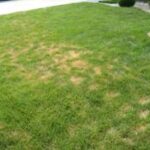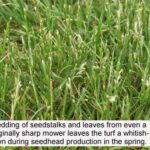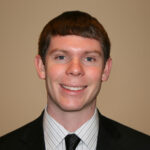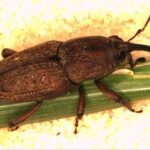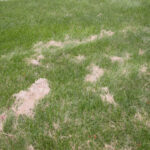Turf Tips Archives
Summer Stress
Part I: Too hot: Why some turfgrass species look poor in summer. There are multiple causes for turf decline in the summer. Cool-season turf areas can decline in the summer because of high temperatures, drought, pest damage (insects, diseases, weeds, others), and due to mismanagement. The general symptoms for many of these causes are usually […]
Gray Leaf Spot 2010
Gray leaf spot has been identified on perennial ryegrass fairways in northern Kentucky. It is likely that outbreaks will occur in southern Indiana with the next rainstorm (or it may already be established). If the turf that you manage has a history of the disease, this would be a good time to consider apply a […]
Contact Information for Dr. Aaron Patton
Dr. Aaron Patton has joined the Turf Program as the Turf Extension Specialist. If you need to contact him, his contact infomation is Phone 765-494-9737 Fax 765-496-6335 email ajpatton@purdue.edu Department of Agronomy 915 W. State Street West Lafayette, IN 47907
Wet and Flooded Turf
Wet Lawns Although July has been relatively dry thus far, June brought a great deal of rain and left many lawn soils saturated and wet. Here are a few tips concerning caring for your lawn during wet periods. Flooded Turf Due to the incredible amount of rain Indiana has seen this summer, many homeowners are […]
Rain gardens and turf
There has recently been increased interest in the use of rain gardens to reduce water runoff in Indiana and nationally. A rain garden is a specially constructed area with a berm, planted with various plants, and designed to capture rain water from the roof of a house or building. Rain gardens fill with water after […]
Call Before Sending Samples to PPDL!
Our Plant and Pest Diagnostic Lab (PPDL) will be a little light on help over the next two weeks (June 19 – July 5). Remember that the lab processes samples from all plants and crops—and even though we try to give turf a high priority—there may be delays in how the samples are addressed. I […]
Slime mold
Slime mold can occur on all turf grasses. The disease does not infect the plant but instead grows on the outside of the leaves. Yellowish, purplish, or grayish fruiting bodies may be observed during wet periods. As the turf begins to dry, the structures become powdery. Since the disease is only cosmetic in nature, chemical […]
Goose Round-up – ‘Yee-Haw’
The Giant Canada goose (Anatidae: Branta canadensis maxima) recently has become one of the most serious pests of parks and golf courses in the Eastern half of the United States. These geese are probably the most adaptable of all waterfowl and, if left undisturbed, will readily establish nesting territories on ponds in residential subdivisions, condominium complexes, city […]
Turf Field Day on July 20
The Turf Field Day will be held on Tuesday, July 20 at the W.H. Daniel Turfgrass Research and Diagnostic Center in West Lafayette. The morning research tours include stops about Plant Growth Regulators, Broadleaf weed products, Controlling Moles and Voles, Dollar Spot Control and Exotic Invasive Insects in Ash and Elm Trees. Tradeshow and equipment demonstration featuring […]
Turf Disease Watch
The near term forecast indicates an early arrival of summer, when temperature and moisture conditions favor diseases that can cause serious damage to turf on golf courses, athletic fields and residential landscapes. Two of the more important diseases are discussed below. Brown Patch Brown patch is a foliar disease that does not damage crowns or […]
Dr. Aaron Patton Joining Purdue as Turf Extension Specialist
When I was 15 years old, I started working at the Indiana University golf course in Bloomington where I cleaned golf carts, helped out on the driving range, and occasionally worked in the pro shop. While there I had the opportunity to meet the golf course superintendent, Brent Emerick, and I began to be more […]
Sharpen Mower Blades
Due to the warm, wet weather we have been experiencing lately, homeowners are having to mow their lawns very frequently. Something to keep in mind throughout the summer is that the more often you mow your lawn, the more dull the mower blades become. Mower blades should be examined a few times throughout the growing […]
May Fertilization
Although it is generally preferable to fertilize home lawns in the fall, a late May fertilizer application can help the turf retain its color and vigor during the summer. If conservative nitrogen rates are used, fertilizer can be applied in late spring without dramatically increasing vertical growth. To aid the turf in keeping its color […]
Managing Seedheads
Kentucky bluegrass, tall fescue and perennial ryegrass all produce seedheads that look unsightly in lawns. These seedheads are easily visible in maintained turfgrass because they grow faster and more unevenly than normal grass blades. Also, since the seedhead stalks are so tough, they do not cut cleanly and leave a light green or white tip […]
James Rutledge Awarded The Musser Award of Excellence
The Musser International Turfgrass Foundation has selected James Rutledge of Purdue as the recipient of the 2010 Musser Award of Excellence. The award, which carries a stipend of $25,000, was announced earlier this year at the Golf Industry Show in San Diego, Calif. Rutledge earned his Bachelor’s and Master’s degrees from North Carolina State University, […]
Hunting Billbugs in Zoysiagrass
Hunting billbug is becoming a significant problem in parts of southern Indiana where zoysiagrass is grown. These insects typically have two generations per year in this part of the Midwest with the larvae of both generations being capable of causing significant injury to turf. Sporadic adult hunting billbug activity has already been observed in the […]
Dandelion Control
Dandelions are one of the most common weeds of maintained turf because they can tolerate a wide variety of soils and environmental conditions. The best time to control dandelions or other broadleaf weeds is in the fall. Mid-spring is also an effective time for control, particularly when dandelions are flowering. If you wait too late […]
Warm Weather and Spring Mowing Woe’s
For those that are managing cool-season lawns like Kentucky bluegrass, the ryegrasses or fescues the unseasonably early warm spring weather has resulted in quite a bit of shoot tissue (leaf clippings) being produced. For many that think they want their lawns to look like a closely cropped and highly manicured golf course, this may have […]
Professionals: Multiple Targeting with Pesticides
As frequent users of pesticides, it is imperative that turfgrass professionals understand the terminology surrounding their formulation and use. For example, when we talk about ‘multiple targeting’ we are referring to an attempt to control more than one pest with a single application of pesticide. Timing of application as well as placement and formulation is critical to success. To time a […]
Spring seeding
Mid-August to mid-September is the best time to seed cool-season grasses. However, sometimes turf is damaged throughout the winter or the previous year and must be seeded in the spring. Spring seeding is difficult so there are a few helpful hints to ensure the most successful outcome. Seeding should take place early in the spring […]
